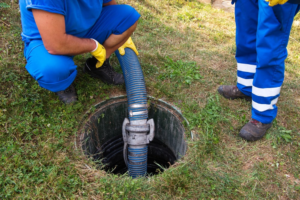Septic Tank Cleaning Perth is one of the most important tasks homeowners need to complete regularly. It prevents costly repairs, improves household safety, and protects the environment.
The septic tank needs to be pumped when the sludge layer is close to the bottom of the inlet or outlet tee (the pipe that brings wastewater into and out of your home). It also helps prevent unpleasant odors and sewage backups.

Many homeowners only give their septic systems a second thought until something goes wrong. A backed-up drain, foul odors or soggy yard signal a problem lurking underground. A well-performing septic system requires routine maintenance to function correctly and safely. Yet there’s some confusion about what exactly that entails. Some people use the terms “cleaning” and “pumping” interchangeably, but they’re two distinctly different services.
Pumping involves bringing in vacuum trucks to fully evacuate liquid effluent and solid sludge waste from the tank and its associated components. This process is usually more expensive than cleaning, but it’s the most straightforward and effective way to remove accumulated debris that reduces the tank’s liquid storage capacity.
During the pumping process, crew members first locate and uncover your septic tank access lid. If this lid is buried, the team might need to dig up six to 12 inches of soil to expose it. Then, the crew uses a high-powered hose connected to a large vacuum truck to suck all of the tank sludge and solids into the truck for disposal.
Once pumped, technicians return to your property and replace the access lid. They might also install a riser to lift the lid above ground level for easier future maintenance access. Then, they’ll clean up the surrounding area and haul away the septic tank contents for treatment and safe disposal in accordance with local regulations.
When septic tanks get too full, the solids in them start to overflow into the drain field and clog the pipes that send wastewater to the soil absorption system. This strains the system and causes wastewater to back up into indoor sinks, showers and toilets. Pumping eliminates this debris and reduces the risk of system failure.
Adding chemical solvents to the septic system to “clean” the septic tank and pipes is never a good idea. These chemicals throw the primordial ecosystem into disarray, killing the microorganisms that naturally break down harmful wastes sent to the septic tank. Moreover, these products may even contaminate groundwater supplies with dangerous bacteria.
Inspection
When your home’s septic system is working well, you may not even be aware that it exists. However, if you suspect problems with your septic tank or wastewater system, it’s important to schedule an inspection by a professional plumber. A septic tank inspection involves checking your entire septic system for signs of problems or failure. A typical inspection includes:
Using a probe to check the soil level near your septic tank. The inspector checks to make sure the septic tank is below groundwater, but not too close to it. If the tank is too close to groundwater, it could contaminate the surrounding environment with toxic waste and allow liquids to enter areas of your drain field where they don’t belong.
Checking for cracks in the tank and septic tank baffles. These are important to inspect because if they crack, sewage could leak out of the tank, into the surrounding area. During the inspection, the inspector will also look at the distribution box to ensure that each drain line receives a similar amount of effluent. If one drain line is receiving a much higher volume than the other, this can cause overflows and blockages.
The inspector will also test for proper functioning of the vents that help to prevent a dangerous buildup of gases inside your septic tank. These vents are normally located in the septic tank’s lid or on top of the drain field, and can be tested by inserting a probe into each opening. The septic tank and septic system should also be checked for the presence of a septic system clean-out, which is a drain line that connects from the house to the septic tank.
The septic tank is designed to hold the waste from all plumbing connections in your home, including toilets and sinks. The weighty masses of sewage sink to the bottom, while lighter materials like grease and oils float to the top, where bacteria break them down into a clear liquid called “effluent.” This effluent flows out of the tank and through the drain field for further natural treatment by soil organisms. When solids, sludge and scum build up in the septic tank and clog the drain field, they can overflow to the ground surface, exposing your family to disease-causing bacteria and contaminating nearby water sources. Regular septic tank cleaning and inspection can keep this from happening, extending the life of your septic system and reducing environmental damage.
Removing Sludge
If your septic tank is overflowing with disgusting sludge, you’ll want to schedule a septic cleaning service. This will not only prevent wastewater from backflowing into sinks, showers and toilets (which could cause massive health problems), but it will also restore your tank’s liquid capacity by eliminating solid obstructions.
Septic tanks are buried, water-tight containers usually made of concrete, fiberglass or polyethylene. They have compartments that separate solid waste from wastewater, which floats to the top of the septic tank as scum and sinks to the bottom as sludge. A septic tank’s microbial ecosystem breaks down the septage and sends the clear wastewater to the drain field, where it’s absorbed into the soil. Over time, the sludge and scum layers will build up until they reach a certain level that requires pumping or cleaning.
Most home septic tanks require cleaning every three to five years. Professionals recommend scheduling a cleaning when the bottom of the floating scum layer is within 6 inches (15.2 centimeters) of the outlet tee, and the top of the sunken sludge layer is within 12 inches (30.4 centimeters) of that same tee. Unlike pumping, which involves a more limited service scope focused solely on the septic tank itself, cleaning eliminates all liquid effluent and sludge from the entire septic system, including the compacted solid waste at the bottom of the septic tank.
Cleaning and pumping both involve digging a hole into the septic tank to uncover its lid, but they use different equipment configurations to empty the waste. For septic cleaning, technicians utilize truck-mounted agitation nozzles and vacuum equipment to dislodge, mix and evacuate the solid waste from the tank. Pumping, on the other hand, calls for a larger tanker truck with vacuum equipment that completely pumps out all liquid waste and sludge from every component of the septic system.
Some septic system maintenance companies offer products that claim to extend periods between pumping and cleaning by accelerating the microbial process already at work in the septic tank. While these products may slightly prolong the period between services, they can also throw off the primordial ecosystem by adding chemical additives that compete with natural enzymes and sludge-digesting bacteria. They can even lead to clogged drains and unpleasant, rotten-egg-scented smells in your home.
Rinsing
During the cleaning process, the septic tank professional also rinses the inside of the septic tank with fresh water. This makes sure that all the scum and gunk is washed away. The septic tank professionals also use the opportunity to inspect the inside of the septic tank for any signs of physical damage, such as cracks or holes. They also use this time to check the condition of the septic tank baffles, which help prevent solid waste from entering the drain field.
The professionals may also use this time to examine the septic tank’s inlet and outlet pipes. If these are in poor condition, they might need to be replaced. Finally, the pros can also use this time to examine the drain field and the surrounding soil for any signs of septic tank failure or problems. They can also look for any areas where the grass is denser or more lush than other areas of the yard.
A septic system can last for decades, but the system will need to be cleaned out periodically. There are a variety of factors that affect how often septic tanks need to be pumped, including the number of people living in a home and how much water is used. The best way to know how often you need your septic tank cleaned is to call a septic service professional.
When septic tanks are cleaned, the professionals will first need to locate the septic tank and determine where it is located. Then, they will dig up the ground to uncover the septic tank. Depending on the size of the tank, this could take up to two hours.
Once the septic tank is located, the professionals will remove the lid and uncover the inlet and outlet sides of the septic tank. Then, they will begin the cleaning process by removing the sludge from the tank.
During this process, the septic tank professional will be careful not to disturb any of the beneficial bacteria that live inside the septic system. These bacteria help to break down the waste that enters the septic system and reduce the amount of solids that need to be removed from the tank. Adding chemical cleaners to the septic tank can throw off this primordial ecosystem and hasten the breakdown of solid waste in the septic system. This can cause health hazards, including typhoid fever and blue baby syndrome (which is characterized by newborns’ decreased ability to receive oxygen in the blood).

